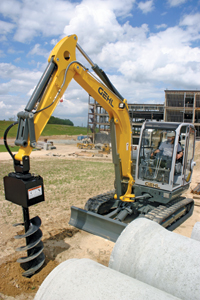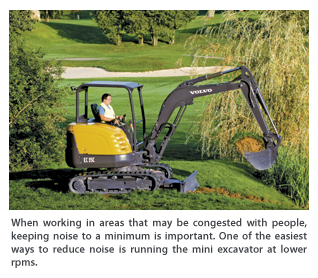Digging Green

 In a time when resources are becoming scarce and environmental concerns make news daily, green practices and products are gaining popularity and importance. From building new homes with recycled materials to driving around in hybrids, this eco-friendly trend is even creeping into the construction vehicles buzzing around jobsites, such as mini excavators.
In a time when resources are becoming scarce and environmental concerns make news daily, green practices and products are gaining popularity and importance. From building new homes with recycled materials to driving around in hybrids, this eco-friendly trend is even creeping into the construction vehicles buzzing around jobsites, such as mini excavators.
With California leading the charge for environmental regulations, other states are expected to follow suit. Manufacturers and operators are pushing for their machines to stay eligible for work and have a cleaner presence on the jobsite. To achieve better efficiency and a greener footprint, owners have a few options including purchasing a new machine, retrofitting an older one or tweaking the way operators run the excavator. Whatever the decision, it’s important to keep in mind what works best for the job and a business’s bottom line.
Something Old, Something New
When searching for the most environmentally-sound mini excavator, buying new may make the most sense. These newly-designed machines offer Tier-compliant engines, advancements in noise reduction and better overall fuel efficiency. But they also offer a hefty price tag, especially in a tough economy. If large equipment payments are not an option, owners can alter their current machines or operating practices to make them efficient, green workhorses.
To make an older excavator more environmentally friendly and/or Tier-engine compliant, the machine can be retrofitted with a new engine or components and accompanying systems. However, manufacturers agree that the costs to create this repowered machine may outweigh its benefits, and owners run the risk of never seeing a return on their investment.
“Retrofitting an older unit would result in some very drastic changes to the machine in order to make the necessary modifications to house new electronics, harnesses, engine radiators and cooling packages,” says Brian Rabe, product manager for Gehl compact excavators. “The changes to machines and engines to meet the regulation requirements are not a simple task and in fact cost engine and excavator manufacturer’s significant time and money in order to meet these requirements.”
The biggest change that can be done to a mini excavator would be to upgrade its engine to be Tier 3 compliant. Retrofitting a current Tier 2 machine would require replacing the current engine, making this task cost prohibitive. In addition, the price of the components that are needed, plus shop labor to retrofit a unit, would most likely only be cost effective if there were a system failure on the excavator.
“We’ve visited with many customers to find out if retrofitting or buying new was in their plan,” says Tom Connor, excavator product specialist for Bobcat. “Of course, their first question is about the cost to repower a machine. We can give some ballparks on that, but there’s very little interest in repowering this type of equipment. It’s just not financially feasible.”
But if a new machine or a repowered one isn’t in the cards for your business, there are plenty of ways to run your mini ex more efficiently. Through simple tips — like ways to decrease fuel usage and noise pollution — operators can get the job done, while saving money and being more environmentally conscious.
Use Less, Save More
Let’s face it. Saving money is a priority for any business owner. Being a friend to the environment is a bonus too. One way contractors can definitely achieve both goals is through increasing their machine’s fuel efficiency. Perhaps one of the easiest ways to improve fuel efficiency while operating a mini ex is to throttle back or reduce engine speed when full power is not needed. Running the machine at a lower engine idle will keep fuel use to a minimum and help save green in the long run.
“Utilize the auto engine idle to minimize fuel consumption and prepare the jobsite to allow the excavator to come in and immediately go to work,” says Dan Rafferty, Volvo product specialist for compact excavators. “Don’t let the excavator idle for excessive periods of time and throttle down the idle to lower fuel consumption if extra speed is not required.”
Attachments also play an important role in fuel usage. When an operator adds an implement to his or her mini excavator, the machine must work harder and burn more fuel. By using the right attachment for the task at hand, crews can keep the amount of fuel that’s used to a minimum.
“Make sure you’re using the right attachment for the job, so you’re not moving more material than you have to,” says Connor. “Make sure you’re digging efficiently. If you have to dig a 24-in. trench, use a 24-in. bucket. It’s the best way to do it. You’ll even see some guys try to break up concrete with a bucket, which can be done, but it’s certainly not the most efficient or recommended way.”
Connor also suggests to plan out a project in advance so an operator doesn’t have to move more materials than needed or move the loads multiple times because the job wasn’t planned out far enough. Besides efficient operation, contractors can also save on fuel by keeping up with the machine’s maintenance regimen. To get a better idea on where to start and what is needed on a daily, weekly and monthly basis, operators should consult the excavator’s manual for the manufacturer’s recommended maintenance schedule. Being diligent about taking care of a mini ex will greatly improve its fuel efficiency.

“Perform regular scheduled maintenance on the entire machine in addition to the engine to minimize the inefficiencies of the entire excavator,” says Rafferty. “Sticking pins require additional force to move and will reduce fuel economy and productivity, as well as dirty hydraulic fluid degrading the pumps performance and dirty engine oil. All these little things add up to significantly deteriorate the machine’s performance.”
Keep It Down
In the push to make machines more environmentally focused, operators and manufacturers are also looking at ways for their excavators to be less obtrusive on the jobsite. Noise pollution has been one of the biggest concerns on the minds of crews working around the public and the operators who sit in the cab all day long.
Reducing noise pollution has become one of the top items for improvement among manufacturers who are designing new product lines. Upgrades include minimizing noise for the operator as he or she sits in the machine, as well as for the bystander around the jobsite.
“Many machines also have noise suppression that is located in the engine compartment that will greatly reduce the amount of noise coming from the engine,” says Robert Jackson, mini excavator marketing and product specialist for Caterpillar. “European standards are slightly higher than the United States and many machines are already using that technology. This can sometimes be added to existing machines if the noise levels from the engine are too loud.”
Operators can minimize noise pollution by running machines at lower rpms and making certain adjustments to older machines, so they can be less disruptive in the area. Modifications can include installing different cooling fans, pumps and motors.
Units may also be outfitted with better insulation and isolation on the components such as the engine and cab. When opting to use new insulation — like foam — to capture and contain noise, owners need to be very careful not to negatively affect the cooling. Replacing original, worn components is also imperative in running a mini ex as quietly as possible.
While modifications to older machines may sound like easy fixes, the cost of these adjustments should be determined ahead of time and considered if they are viable in the long run.
“To truly lower noise from the machine is a pretty big challenge because you’re affecting many of its systems — exhaust, air intake, cooling and pumps,” says Connor. “It can become very difficult to do these things on existing products, especially when you look at it financially. Can you make dollars and cents out of doing it? It’s not feasible to upgrade a machine to reduce noise if the return isn’t there.”
Whether it’s buying a new machine, or learning to use an older one more efficiently, being focused on green practices is a trend that’s not going away any time soon. Through smart operation, crews can run their mini excavators both proficiently and environmentally friendly.
Pam Stask is assistant editor of Compact Equipment, based in Peninsula, Ohio.
Staying Inside
Equipment Options Help Operators Safely Work Indoors
Moving a job indoors can become a common project requirement, especially in buildings like factories and shopping malls. When working on indoor or semi-indoor applications, carbon monoxide and engine emissions become a concern. To counteract those fears and make working indoors a bit safer, mini ex manufacturers offer equipment options such as diesel particulate filters and catalytic mufflers to help clear the air.
Diesel particulate filters reduce soot particles from the exhaust gases, improving exhaust air quality. “However, this system does not eliminate carbon monoxide, which is a dangerous gas for any work done in an enclosed area,” warns Brian Rabe, product manager for Gehl compact excavators.
A diesel scrubber/catalytic muffler can reduce the amount of emissions from the engine, helping to improve the air quality of a structure that an operator and crew are working in.
On top of machine modifications, an operator should also factor in how much air is coming in and out of the enclosure he or she is working in. Dan Rafferty, Volvo product specialist for compact excavators, adds that properly venting the operational area to the outside is the best way to minimize operator exposure to engine emissions.

Comments are closed here.